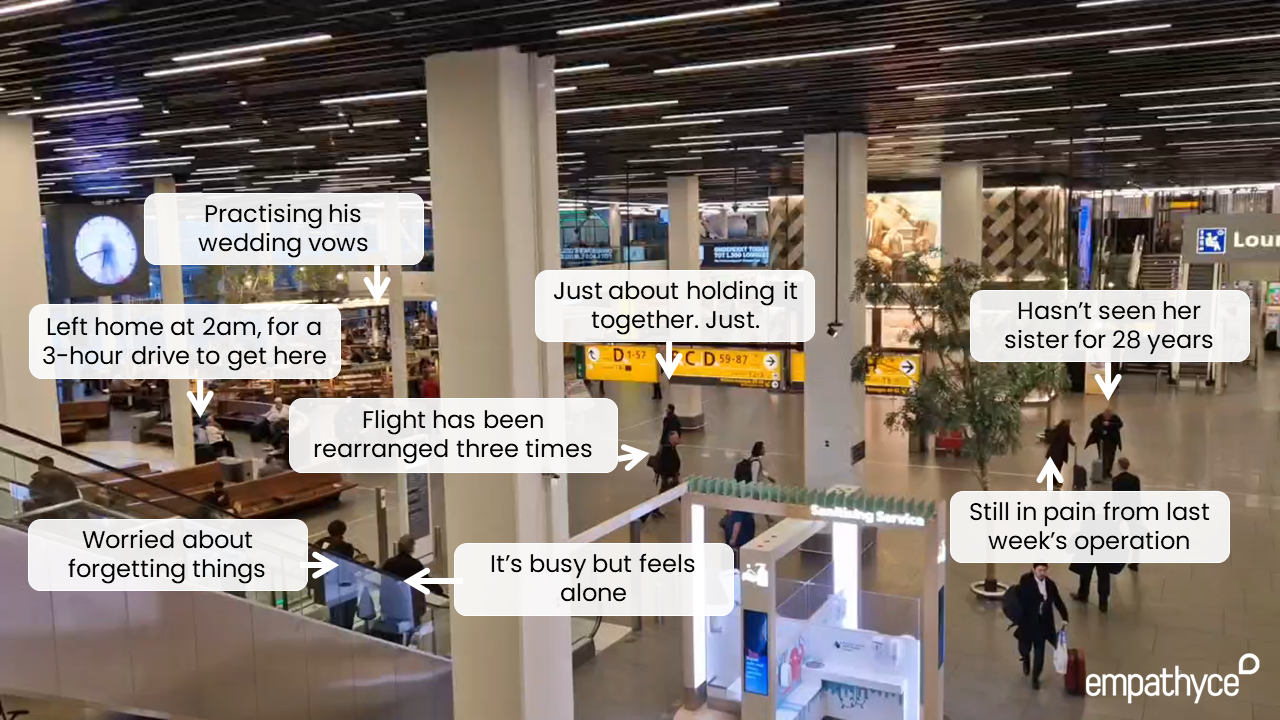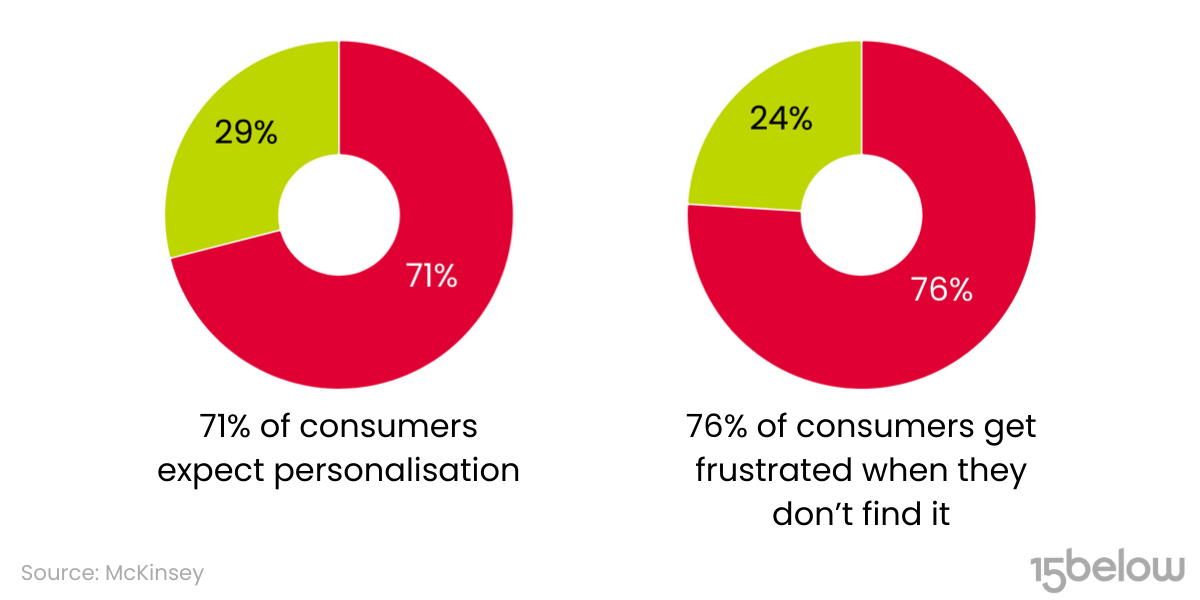30 January 2024 | Blog
The art of empathy: How to enhance airline customer experience with effective communication
30 January 2024 | Blog
The art of empathy: How to enhance airline customer experience with effective communication
Empathy is the ability to genuinely understand and share the feelings of others. But it is not just a display of compassion; when used well it is a powerful tool that will elevate a customer experience. When customers feel understood, they are more likely to develop a positive perception of a brand, driving loyalty and repeat business.
The experience of air travel goes far beyond simply getting from one destination to another; each journey involves countless emotions for every customer, triggered by factors both within and outside an airline’s control.
At our 2023 Customer Conference, Jerry Angrave, founder at customer experience consultancy Empathyce shared a powerful image that highlighted:
No matter how experienced your passengers are, you can never know what is happening in their lives that could be adding complication, strain, and unpredictable emotions to their journey.

What using empathy in your passenger communications looks like
We've previously talked about why Effective communication is a key factor in delivering an outstanding customer experience. In the context of the aviation industry, using empathy involves recognising the emotional state of passengers during each stage of their journey and communicating with them in a way that leaves them calm, informed, and empowered. From the excitement of a trip of a lifetime, to the anxiety of a first-time flyer or the stress caused by travel disruption, each passenger's emotions are personal and nuanced.
“Consumers don’t just want personalization, they demand it.”
Here are six practical ways airlines can demonstrate empathy through effective communication:
1) Personalisation requires more detail than you might think
Research by McKinsey shows that 71% of consumers expect personalisation.

Airlines have access to huge amounts of data from multiple sources that they can leverage to offer a hyper-personalised experience. Combining the data available in the PNR with information from a CRM system, loyalty system and FLIFO feed will form a detailed picture of your passenger that no single data source alone can provide. However, it’s important that these systems are integrated automatically as manual data extraction will result in a very poor customer experience.
2) Consider your timings
Keeping passengers informed with relevant information is crucial, but this is just one part of the equation. Timing is also incredibly important and we encourage our customers to consider three elements, particularly during acts of disruption:
- Aggregation: This involves determining how often customers will receive updates so they remain informed without being overwhelmed by too many notifications.
- Using sociable hours: A good example is not waking someone up at 2am to tell them something that can wait until the morning. Clear and timely communication helps manage expectations and reduces anxiety where it’s not necessary.
- Deferral: These rules can make sure staff are aware a certain number of minutes before travellers, and your subscribers can be informed a little later too. To fully embrace empathy in your operations, you need to think about every affected party.
3) Embrace empathetic language
Thinking about the language you’re using is a great way to show your customers that you’re thinking about them. Simple phrases like "we understand this is frustrating" or "we know you’ve been disrupted flying with us before" (use your CRM system to get this sort of insight) can go a long way in making passengers feel cared for.
But empathetic language doesn’t just have to look like “we’re sorry”. Another way to show empathy is to change the way you display the information. We convert elements like carrier name, fare class, SSRs and status codes into “friendly” terms so that they are easy to understand.
Whilst taking away unnecessary stress, you’ll also benefit from a reduction in calls from confused customers to your contact centre.
4) Don’t make passengers go to the airport to stay informed
Staying in touch is key to keeping your customers informed and anxiety-free. During an IROP, if you don’t have any new information, make sure your passengers know that you’ll contact them once they need to act. Let them stay at home or by the pool rather than making them queue at the airport. In the case of a two-hour delay, we advise our customers to send an update every 15 minutes, even if it simply says, “We don’t have any more information, but there is no need to come to the airport yet.” As long as you can deliver on your promises, you will earn trust and loyalty in this scenario.
5) Use the right channel for the moment
The channel you use to communicate with a passenger will depend on a number of factors, including:
- The information you’re sharing – Do you need to include rich data such as a QR code or boarding pass?
- Their demographic - Each generation and culture embraces channels and platforms differently, and this is constantly changing.
- The urgency of the message – Do they need to know a change to their flight immediately?
- Accessibility – Do they have access to the internet?
Once you have considered all of the above, you will discover that it’s impossible to offer empathy whilst relying on a single communication channel. Instead, you will need to employ an omnichannel approach, which you can learn more about in our on-demand webinar.
6) Anticipate needs and offer assistance
Use information in the PNR to proactively anticipate passengers' needs and offer assistance they may not know is available. For instance, getting in touch with elderly passengers or families with multiple small children to offer them help at the airport. Using a pre-departure communication to link these to ancillary services will result in a great experience for your customers and additional revenue for you.
How can airlines improve passenger experience using empathy?
Empathy is the foundation of a remarkable customer experience and effective communication plays a significant role.
A technique that we encourage our customers to use to genuinely understand and empathise with their customers is Customer Journey Mapping. This is an exercise that encourages every part of a business to play its role in developing an outstanding experience for each of its customers at every stage of their journey.
Find out more about the practice of Journey Mapping, along with a foreword and interactive workbook from aviation CX expert Jerry Angrave in our eGuide, Ensuring your Customer Journey Mapping is effective, strategic and influential.




